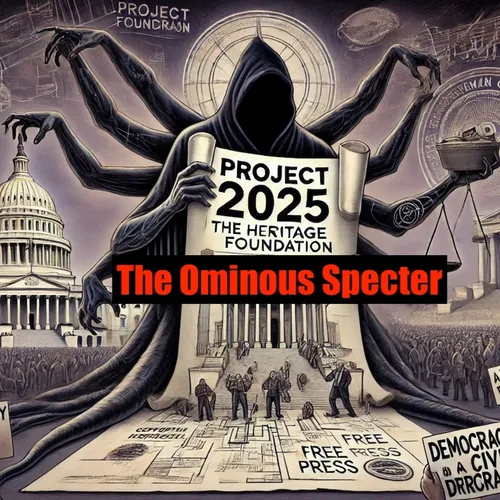"Unveiling Project 2025: A Sweeping Conservative Agenda to Reshape American Governance"
- Author
- Quiet.Please
- Published
- Tue 15 Apr 2025
- Episode Link
- https://www.spreaker.com/episode/unveiling-project-2025-a-sweeping-conservative-agenda-to-reshape-american-governance--65584930
As I delve into the intricacies of Project 2025, a sweeping initiative spearheaded by the conservative Heritage Foundation, it becomes clear that this is more than just a policy manual – it's a blueprint for a fundamental transformation of American governance.
Project 2025 is the culmination of efforts from over 100 respected organizations within the conservative movement, aiming to "take down the Deep State" and return the government to the people. This ambitious plan, outlined in a 900-page manual, involves hundreds of individual policy changes that touch nearly every aspect of American life. From immigration and abortion rights to education and energy production, the scope of Project 2025 is vast and its implications profound.
One of the most contentious areas addressed by Project 2025 is immigration. The plan calls for securing the border, finishing the construction of the wall, and deporting illegal aliens. It also proposes transferring the custody of immigrant children from the Department of Health and Human Services (HHS) to the Department of Homeland Security (DHS), a move that critics argue would prioritize enforcement over welfare and potentially worsen the safety and psychological well-being of vulnerable children[5].
In the realm of reproductive rights, Project 2025 advocates for drastic measures. It suggests reviving the 19th-century Comstock Act to ban abortion medications and materials from being sent through the U.S. Postal Service and reversing the FDA’s approval of mifepristone, a key medication used in abortions. These proposals are part of a broader effort to gut abortion access, with supporters like Pam Bondi, who defended President Trump during his first impeachment trial and upheld Florida’s restrictive abortion ban, actively working to implement these changes[3].
Education is another sector that would undergo significant changes under Project 2025. The plan aims to dismantle the federal role in education, proposing the abolition of the Department of Education and the privatization of student loans. It also recommends eliminating the Public Service Loan Forgiveness program and increasing taxes on university endowments. Sara Partridge, associate director of higher education policy at the Center for American Progress, notes that "the way I see it, Project 2025 really set out to destroy the federal role in education as we know it, and this administration has already taken major steps to weaken it"[4].
The energy sector is not immune to the project's ambitious reforms. Project 2025 advocates for unleashing American energy production to reduce energy prices, including expanding energy exploration and extraction in Alaska and opening the National Petroleum Reserve to leasing and development. This aligns with broader conservative goals of reducing regulatory barriers and increasing domestic energy production[2].
A key aspect of Project 2025 is its focus on restructuring the federal government to make it more accountable to the democratically elected President and Congress. This includes proposals to de-weaponize the Federal Government by increasing accountability and oversight of the FBI and DOJ, and to implement Trump’s Schedule F executive order, which would allow for the dismissal of ‘non-performing’ federal employees. This measure could significantly erode the system of checks and balances by centralizing power in the executive branch[5].
The project also delves into social issues, such as banning biological males from competing in women's sports, a policy that reflects the conservative movement's stance on gender and sports[1].
Despite President Trump's denials of direct involvement, the connections between Project 2025 and his administration are evident. The Heritage Foundation, which published the project, has direct ties to Trump’s first administration, with at least 140 people who worked on Project 2025 having...
